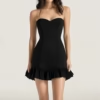Finding a boutique niche is one of the most critical steps in establishing a successful retail business. It’s about pinpointing a specific segment of the market that you can cater to better than anyone else. Here’s how you can discover the perfect niche for your boutique:
1. Self-Assessment
Start by assessing your interests and passions. Consider the types of products you are genuinely excited about and which reflect your personal style. If you’re passionate about what you’re selling, it will naturally translate into a more authentic and engaging boutique.
2. Market Research
Conduct thorough market research to understand the current landscape. Analyze trends, consumer behaviors, and gaps in the market. Look for areas where demand outweighs the supply. Tools like Google Trends, industry reports, and competitor analysis can provide valuable insights.
Example:
- Tools: Google Trends, IBISWorld Reports
- Steps: Identify growing trends and underserved markets.
3. Identify Target Audience
Consider who your ideal customers are. Define their demographics, psychographics, and shopping habits. Understanding your target audience’s needs and preferences will help you tailor your product offerings to meet their specific demands.
Example:
- Demographics: Age, gender, income level.
- Psychographics: Lifestyle, values, interests.
- Shopping Habits: Online vs. in-store, brand loyalty, price sensitivity.
4. Analyze Competitors
Study other boutiques to see what niches they are serving and how they’re doing it. Look for successful boutiques and identify what sets them apart. Conversely, identify what they might be missing and see if you can fill that gap.
Example:
- Competitors: Analyze stores like Zara, Urban Outfitters.
- Gap Identification: Are there segments they are not catering to?
5. Focus on Solutions
Identify problems or pain points in the market that your boutique can solve. This could be anything from offering sustainable fashion to providing plus-size clothing in trendy styles. Focusing on solving these issues can help carve out a niche.
Example:
- Sustainability: Offer eco-friendly fashion.
- Inclusivity: Offer a wide range of sizes and body-positive apparel.
6. Test Your Niche Idea
Before fully committing, test your niche idea on a small scale. Use social media platforms to gauge interest, run surveys, or launch a small collection to gather customer feedback. This will help determine if there’s a viable market for your niche.
Example:
- Social Media: Instagram polls, Facebook surveys.
- Launching Small Collections: Kickstarter campaigns, pop-up shops.
7. Create a Unique Selling Proposition (USP)
Develop a strong USP that clearly defines what makes your boutique different. Your USP should communicate the unique benefits and value that your niche offers to your target customers.
Example:
- USP: “Sustainable luxury fashion for eco-conscious women.”
Final Thoughts
Finding the right boutique niche involves a blend of self-reflection, market analysis, and a deep understanding of your target audience. By focusing on specific needs and preferences, you can carve out a unique space in the market and build a loyal customer base.
For more tips and resources on starting your boutique, explore Stylebuy.net, a trusted platform for connecting with premium clothing wholesalers and staying updated on the latest market trends.
Related
















































